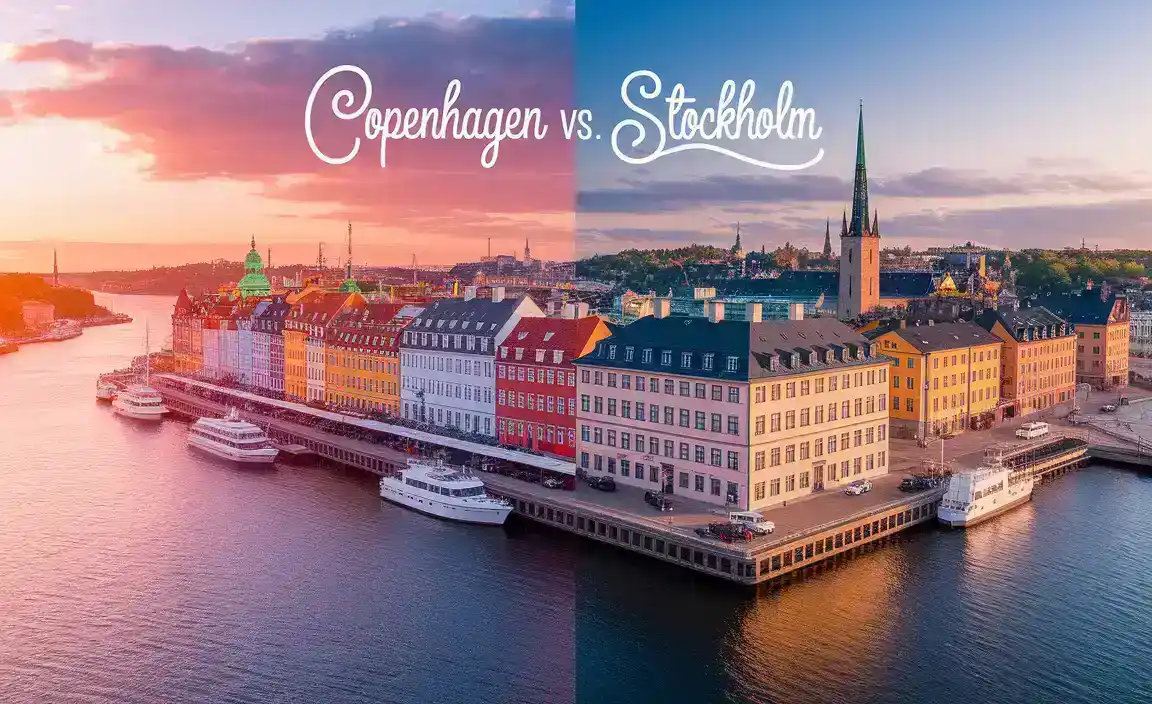Have you ever wondered what it’s like to step back in time? Imagine walking through streets that have stories to tell. In Norway, historic towns offer just that experience. You can find colorful wooden buildings, cobblestone streets, and fascinating museums. Each town has its own unique charm and history.
For example, did you know that some towns in Norway date back to the Viking Age? They were once bustling centers of trade and culture. Today, they still hold onto that rich past, welcoming visitors from all over the world.
Exploring Norway’s historic towns is like reading a real-life storybook. You can learn about the people who lived there long ago. You might discover how they built their homes and what their daily lives were like. Are you ready to uncover the secrets of these amazing places?
Explore The Most Captivating Historic Towns In Norway
Norway is home to many historic towns, each with its own stories and charm. Towns like Bergen, with its colorful wooden houses, invite you to explore. Did you know some buildings date back to the Middle Ages? You can wander through cobblestone streets and imagine life from long ago. Other towns, like Røros, offer a peek into mining history. Visiting these historic spots helps you understand Norway’s rich heritage and its stunning landscapes.
Bergen: The Gateway to the Fjords
Explore the UNESCO World Heritage Site of Bryggen.. Learn about its trading history and vibrant cultural scene..
Bergen holds a special place as the gateway to Norway’s stunning fjords. The town is famed for its UNESCO World Heritage Site, Bryggen. These colorful wooden buildings tell tales of traders from long ago. Imagine merchants hustling about, exchanging goods and secrets, like a medieval flea market! Today, Bryggen is vibrant, filled with art galleries and cozy cafes. It’s the perfect spot to learn about Bergen’s rich trading history while enjoying a warm cinnamon bun.
| Attraction | Description |
|---|---|
| Bryggen | Colorful wooden buildings from the 14th century. |
| Cultural Scene | Art, shops, and cozy cafes fill the area. |
Ålesund: Art Nouveau Architecture
Examine the unique architecture styles post1904 fire.. Discover local attractions such as the Atlantic Sea Park..
After the big fire in 1904, the town of Ålesund rebuilt itself in a dazzling style known as art nouveau. This architecture features playful shapes and colorful details, making the buildings look like they belong in a fairy tale. People say it’s like stepping into a painting! While wandering around, don’t miss local gems like the Atlantic Sea Park, where you can see seals and maybe catch a fishy performance. It’s fun for everyone!
| Attraction | Description |
|---|---|
| Atlantic Sea Park | A great place to watch seals and learn about sea life. |
Stavanger: A Blend of History and Modernity
Review the historical significance of old wooden houses in Gamle Stavanger.. Discuss its role in Norway’s oil boom and contemporary arts..
In Gamle Stavanger, you will find charming old wooden houses that tell stories from the past. These colorful homes show us what life was like for fishermen and traders long ago. Today, they stand proudly, reminding us of Norway’s rich history. During the oil boom, Stavanger transformed into a bustling city, but it still holds onto its roots. Now, artists fill the streets with creativity, making modern art speak through historic walls. It’s like history and art had a delightful dance!
| Feature | Description |
|---|---|
| Old Wooden Houses | Beautifully preserved homes from the 18th and 19th centuries |
| Oil Boom Impact | Brought economic growth and modern businesses to Stavanger |
| Arts Scene | A vibrant place where street art and galleries thrive |
Trondheim: A Medieval City at Its Core
Highlight the Nidaros Cathedral’s historical importance.. Explore the city’s Viking heritage and student culture..
Trondheim is a city filled with history. The Nidaros Cathedral is a key part of this. Built in the 11th century, it remains the northernmost medieval cathedral in the world. This cathedral is important for its stunning architecture and its role as a burial site for kings. Trondheim also has deep Viking roots, showcasing how people lived long ago. Today, it is home to many students, bringing a lively energy to the streets. The mix of ancient and modern makes Trondheim special.
What makes Nidaros Cathedral so important?
The Nidaros Cathedral is important because it is the first church built over the grave of a king. It has served as a pilgrimage site for many.
Why is Trondheim known for its Vikings and students?
- Trondheim was an ancient Viking capital.
- The city has a famous university that attracts many students.
Røros: A UNESCO World Heritage Gem
Understand the significance of copper mining in Røros’ development.. Showcase the town’s unique wooden buildings and artisanal craftsmanship..
Røros is a special town with deep roots in copper mining. This industry shaped its growth and made it a bustling place. Many buildings in Røros are made of wood. They have unique designs that reflect the town’s rich history. Skilled artisans crafted these homes, showcasing their talent. The charm of Røros lies in its colorful buildings and intricate craftsmanship. Walking here feels like stepping back in time.
What makes Røros a UNESCO World Heritage Site?
Røros was recognized for its history and well-preserved wooden architecture. It highlights the town’s mining past and craftsmanship, making it a true gem in Norway.
- Copper mining drove economic growth.
- Unique wooden buildings showcase craftsmanship.
- Artisans still honor traditional skills today.
Fredrikstad: A Fortress Town
Learn about the starshaped fortress and its historical context.. Discuss modern attractions within the wellpreserved old town..
Imagine walking through a town shaped like a star! Fredrikstad offers this unique gem with its old fortress. Built in the 17th century, it protected against invaders, while the town flourished. Today, you can stroll through charming streets filled with colorful wooden houses and cozy cafes. Explore museums that tell the tales of long ago or grab a coffee and watch the world go by. It’s history mixed with fun—like a time machine that also serves *delicious* pastries!
| Attraction | Description |
|---|---|
| Fredrikstad Fortress | A star-shaped fortress with a rich history. |
| Old Town | Well-preserved streets filled with shops and cafes. |
| Museums | Learn about the town’s history and culture. |
Kongsvinger: A Historical Fortified Town
Explore Kongsvinger Fortress and its military significance.. Review cultural events and local traditions in Kongsvinger..
Kongsvinger is known for its impressive fortress. This stronghold played a key role in Norway’s military history. You can explore the fortress and learn about its importance. On special occasions, Kongsvinger hosts cultural events and festivals. These events show the town’s rich traditions and local pride.
- Guided fortress tours
- Annual festivals, like Kongsvinger Day
- Shows of local crafts and food
Visitors can enjoy music, dance, and tasty snacks. Kongsvinger’s culture is alive and engaging!
What can visitors do at Kongsvinger Fortress?
Visitors can explore the fortress, learn its history, and enjoy guided tours. It’s a fun way to see the past come alive!
Lofoten Islands: A Historic Fishing Community
Discuss the history of fishing and its impact on local culture.. Investigate traditional rorbu (fishermen’s cabins) and their significance..
Fishing has shaped the Lofoten Islands’ culture for centuries. This historic fishing community once supplied fish to hungry Viking ships! The local men and women worked hard, creating a vibrant way of life. Traditional rorbu, or fishermen’s cabins, still stand today. They remind us of the past. Tourists can rent these cozy cabins for a taste of history. Just imagine being a fisherman, sipping coffee while dreaming of the big catch!
| Significance of Rorbu | Highlights |
|---|---|
| Historic Importance | Symbol of local culture |
| Tourist Appeal | Unique rental experience |
| Architectural Charm | Colorful structures by the sea |
Haugesund: Birthplace of the Viking Kings
Delve into Viking history and heritage sites in Haugesund.. Explore annual Viking festivals and cultural events..
Haugesund is rich in Viking history. This area is known as the birthplace of Viking kings. Visitors can explore many heritage sites, like the famous Avaldsnes. This site has a Viking museum and a reconstructed farm. Every year, Haugesund hosts exciting Viking festivals. These festivals include fun activities like traditional games and sword fighting shows. It’s a chance to learn about Viking culture and meet amazing people!
What can visitors experience during Viking festivals in Haugesund?
Visitors can enjoy reenactments, crafts, and delicious Viking food. Music and dancing fill the air, making it a fun experience!
Insights into Local Culture and Traditions
Discuss the influence of history on modern Norwegian culture.. Explore local festivals, customs, and their historical backgrounds..
Norwegian culture is rich with history. The past shapes modern traditions. Festivals celebrate events from long ago. Every spring, people enjoy Sankthans, or Midsummer. They light bonfires and gather in joy. Constitution Day on May 17th is another big celebration. It marks Norway’s independence. Locals wear their beautiful traditional costumes, called bunad. These outfits show pride in their roots. Understanding these events helps us see how history lives on in today’s Norway.
What are some key festivals in Norway?
Sankthans and Constitution Day are key festivals that highlight Norwegian history and culture.
Key Points about Festivals:
- Sankthans: Celebrated in June with bonfires.
- Constitution Day: Celebrated on May 17 with parades and traditional costumes.
Conclusion
In conclusion, historic towns in Norway offer amazing sights and stories. You can explore charming streets, old buildings, and rich cultures. Places like Bergen and Alesund are must-visits. We encourage you to plan a trip or read more about these towns. Discover their unique histories and enjoy the beautiful scenery they offer. You won’t be disappointed!
FAQs
What Are Some Of The Most Well-Preserved Historic Towns In Norway, And What Unique Architectural Features Do They Showcase?
Some of the best-preserved historic towns in Norway are Bergen, Røros, and Ålesund. Bergen has colorful wooden buildings along the waterfront. Røros is famous for its old wooden houses and mining history. Ålesund has beautiful Art Nouveau style with fancy decorations. Each town shares a special link to Norway’s past!
How Did Norway’S Cultural Heritage During The Viking Age Influence The Development Of Its Historic Towns?
Norway’s Viking Age shaped its towns in many ways. Vikings built strong ships and traded across waters. This helped towns grow by connecting people. They also created beautiful art and stories about their gods. Their culture made towns lively places where people wanted to live and work.
What Role Did Trade And Commerce Play In The Establishment Of Norway’S Historic Towns Throughout The Middle Ages?
Trade and commerce were really important for Norway’s towns in the Middle Ages. People bought and sold goods like fish, timber, and wool. This helped towns grow bigger and stronger. As more people came to trade, they built houses and shops. So, trade made towns lively places where everyone could live and work together.
Which Historic Towns In Norway Are Recognized As Unesco World Heritage Sites, And What Makes Them Significant?
In Norway, two historic towns are UNESCO World Heritage Sites. They are Bryggen in Bergen and Rjukan-Notodden Industrial Heritage Site. Bryggen is famous for its old wooden buildings by the harbor. Rjukan-Notodden is important for its role in making power from waterfalls and helping in industry. Both towns show us how people lived and worked in the past.
How Have Modern Tourism And Conservation Efforts Impacted The Preservation Of Norway’S Historic Towns?
Modern tourism helps us keep Norway’s historic towns safe and beautiful. When people come to visit, they spend money, which helps fix old buildings. We also learn to take better care of these places to protect their history. Conservation efforts make sure we preserve the towns for future generations. This way, everyone can enjoy their charm!







